#Overwintering vegetables
Explore tagged Tumblr posts
Text
Mastering the Art of Year-Round Vegetable Gardening: Tips, Techniques, and Inspiration
Discover the secrets to cultivating a thriving vegetable garden all year round with our comprehensive guide, "Mastering the Art of Year-Round Vegetable Gardening: Tips, Techniques, and Inspiration." Whether you're a seasoned gardener or just starting out, this resource is your go-to reference for achieving continuous harvests and keeping your garden vibrant in every season. Uncover expert tips on extending the growing season, protecting plants from frost, maximizing indoor gardening spaces, and selecting the right winter vegetable varieties. With step-by-step instructions, innovative techniques, and inspiring ideas, this guide empowers you to create a bountiful and sustainable vegetable garden that yields fresh produce throughout the year. Start your year-round gardening journey today and enjoy homegrown goodness in every season.
#Year-round vegetable gardening#Four-season vegetable garden#Winter vegetable garden#Indoor vegetable gardening#Cold weather gardening#Extending the growing season#Frost protection for vegetables#Greenhouse gardening#Container gardening in winter#Winter vegetable varieties#Winterizing your vegetable garden#Growing vegetables in low light conditions#Overwintering vegetables#Seasonal vegetable garden planning#Cover crops for winter gardening#Protecting plants from frost#Cold frame gardening#Indoor hydroponic gardening#Mulching for winter vegetable garden#Year-round crop rotation
0 notes
Text
October 2024: Curbside Find, Harvests & Early Voting
I found this firepit on the curb while dog walking:

Refurbished after a good cleaning & few coats of heat resistant paint:

Thursday harvest:

Friday harvest:

We're going to try overwintering pepper plants indoors again:

Saturday harvest:

Our ginger is starting to bud:

Old & new Chrysanthemums that we transplanted to these pots:

The bees of Saturday:





The Red Menace enjoying the sun:

The front yard volunteer cucumbers have slowed a bit but are still producing:

We got our early vote on Saturday. In addition to the elections, there were several referendums to amend The City's charter. One of the referendums, No. 5908, related to 3 amendments aimed at curbing gun violence in the city. The Republican-controlled state house and senate fought to have those referendums kept off the ballot and, when they lost in court, they withheld state tax revenue funds due to the city.
As is our tradition, we made a date out of it by going to a restaurant afterwards:

Me back at the house:

#curbside find#firepit#refurbished#garden#backyard garden#gardening#vegetables#homegrown vegetables#harvest#tomatoes#pole beans#overwintering#pepper plants#ginger#ginger plant#flowers#chrysanthemum#bees#bee#insects#beneficial insects#carpenter bee#sweat bee#blue salvia#honeybee#honey bees#honey bee#cosmos#bumblebee#dog
8 notes
·
View notes
Text

One last vegetable this season.
#cauliflower#gardening#vegetable garden#i just thought the picture looked nice#this last one is bigger than the other two#it's still nearly 90 out so it sure doesn't feel like fall but everything is dying anyway#this weekend i need to go out and pull everything and overwinter
7 notes
·
View notes
Text


9 days until Spring and this is a snap shot of what's going on in my capsicum patch.
These babies have over wintered so well in their little micro climate next to a sunny brick wall. These plants are about 4 years old now.
I fed them today, gave them a fresh top of soil and mulch. Grow season is just around the corner!
#capsicum#garden#gardeners on tumblr#vegetables#gardening#self sufficiency#home grown#plants#organic food#quadrato d'asti giallo#micro climate#overwintering
7 notes
·
View notes
Text

[ID: Three strawberries, the background is white with circles made of blue spots. End ID]
Got excited by the fact that I am actually getting a strawberry crop this year and decided to play food photographer!
#dont remember what the variety is#we overwintered them to see if they would make it and the plants loved it#got big and sent out loads of runners and are blooming tons#last year i got less than a dozen total and we are gonna get that just in this week#we dont grow these for a real crop or anything they are mostly just an experiment and a living mulch/groundcover for cucumbers#so actual fruit is a nice bonus#strawberries#vegetable gardening#moss’s garden#ecdysing#food#food pictures
2 notes
·
View notes
Text
garden update // august 27th 2024
it's greenhouse time.


besides the fact that the next two days have a heat index over 100°F... but trying REALLY HARD to keep these fall babies nice and cool. walking egyptian onions and microdwarf tomatoes won't mind the heat. but the kale and peas will!! hopefully they will be ok, and once this heat wave is over i'm starting soooo many more trays.


this time of year is perfect for planting any perennials, btw. i ordered me another little miss figgy to go with my first one. do i need two? no. but i feel like two is a good number for my garden. i have two blueberry bushes and two prickly pears, so why not two figs. the blue plastic containers have the bottoms cut off - a makeshift raised bed until i can build the one i really want around it. someday. it's also the perfect time of year to get hot peppers out of the ground and into the greenhouse for overwintering. they don't mind at all, and then next spring these babies will go right back into the ground (or sold at the market).


these two tall raised beds are gonna be for my garlic this winter. one has pepper plants that i'll be transplanting soon so i can top off with compost and i can get my softneck garlic started, but the other one. the other one is going to be a little bit of a worry. right now it's overflowing with sweet potato vine (and hoprfully full of purple sweet potatoes!) but i thought harvesting them was in september. turns out sweet potatoes you harvest the day before first frost... weeeee bit too late for garlic. i ordered some hardneck garlic so i can offer that next year to put here, but looks like i'll need to find a different spot for them or hope for the best. haven't decided yet.

1st year raspberry canes are turning yellow, which means they'll be ready to transplant to their final home soon. only issue is i haven't even BEGUN to get their final home ready 😐 they are going to replace the azalea bushes in the background, since they don't get shade anymore. hard to believe the front yard was full shade when we bought this house in 2016 and now there's not one bit of shade to be found - just yummy vegetables and fruit! (i'm stalling so i don't have to go outside and start ripping up azaleas shhhh). raspberries produce on 2 year old canes (or wood, stems, etc. idk why they call them canes) so transplanting them this fall is crucial.
i swear on my little miss figgy bushes that once this heat wave is gone it's go time. chronic illness PLEASE cooperate thank you 🙏
#gardening#home garden#food not lawns#homestead#homesteading#nature#homegrown#food#grow food#gardenblr#garden blog#suburban agriculture#suburban farm
19 notes
·
View notes
Text
Warbler Showdown; Bracket 7.2, Poll 3


Nashville Warbler (Leiothlypis ruficapilla)
IUCN Rating: Least Concern
Range: migratory; each subspecies has a separate breeding range, with one covering the Northeast and northern Midwest, as well as the Canadian Providences above them and the other breeding in the Pacific Northwest, California, Idaho, and Montana, as well as British Columbia. Both overwinter in Mexico, especially along the southwestern states of the country, though the Western subspecies is sometimes found in California.
Habitat: second growth, open deciduous, or mixed-species forests; western birds occur and nest in higher elevation than their eastern counterparts. Overwinter in low deciduous open forests and suburban gardens.
Subspecies: 2
Pink-headed Warbler (Cardellina versicolor)
IUCN Rating: Least Concern
Range: resident (non-migratory); found in a small section of Chiapas in Mexico and the Guatemalan highlands
Habitat: pine-oak and montane evergreen forests, with a preference for the edges and secondary vegetation.
Subspecies: none
Image Sources: Nashville (Gracie McMahon); Pink (Ana Paula Oxom)
#nww showdown#parulidae#passeriformes#new world warbler#wood warbler#polls#bird poll#(I call this one.... murder)#(actually I'm surprised to see how this goes. NAWA or CANW were the two who could stand up to Pink)
20 notes
·
View notes
Text
Moth of the Week
Angle Shades
Phlogophora meticulosa
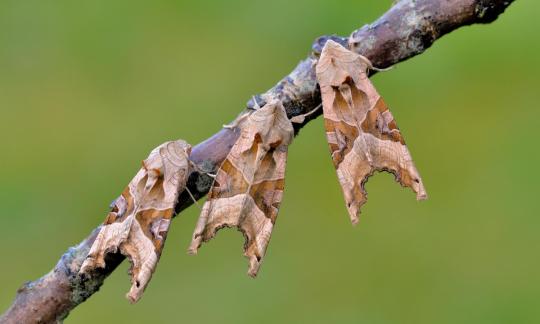
Image source
The angle shades is a part of the family Noctuidae. This species was first described in 1758 by Carl Linnaeus. According to Wikipedia, this moth gets its common name from the colors and marking on its wings.
Description The forewings of this moth are shaped with a sharp point. Most of the forewing is buffish as well as the head, legs, body, and antennae. The middle of the forewing is split by a triangle. The bottom of the triangle lays on the termen of the forewing or “the edge of the wing most distant from the body.” The triangle is made of layers of brown and pink. The hindwings are whitish with darker veins.
ab. roseobrunnea ab. nov [Warren], the central triangle is a rich red brown tinged with fulvous (tawny/orange), the whole wing reddish tinged, and the green shades all strongly mixed with red, the metathorax and dorsal tufts also being deep fulvous instead of green; found in São Jorge Island in the Azores
Wingspan Range: 45 - 52 mm (≈1.77 - 2.05 in)
Diet and Habitat This species eats a wide range of herbaceous plants such as Common Nettle (Urtica dioica), Hop (Humulus lupulus), Red Valerian (Centranthus ruber), Broad-leaved Dock (Rumex obtusifolius), Bramble (Rubus fruiticosus), Hazel (Corylus avellana), birches, oak, basil, and broccoli.
They are distributed throughout Europe. Their reach spans eastto the Urals, southeast to Syria, Armenia, and Asia Minor, west to Azores, and south to Algeria. They are a strongly migratory species. It is found in a variety of habitats such as gardens, hedgerows, fens, woodland, grasslands, farmland, wetlands, heathland, and moorland.
Mating This moth is generally seen from May to October and has two generations per year. The larva overwinter in soil as pupa.
Predators This species flies mainly at night. They are presumably preyed on by nighttime predators such as bats. This moth uses its coloration to disguise itself as a wilted leaf when at rest. They can be seen during the day resting on walls, vegetation, and feces.
Fun Fact The angle shades is attracted to light and sugar.
(Source: Wikipedia [1][2], Butterfly Conservation, The Wildlife Trusts)
#libraryofmoths#animals#bugs#facts#insects#moth#lepidoptera#mothoftheweek#angle shades#Phlogophora meticulosa#Noctuidae
52 notes
·
View notes
Text








The giant leopard moth (Hypercompe scribonia) is a moth of the family Erebidae. They are distributed through North America from southern Ontario, and southern and eastern United States through New England, Mexico, and south to Colombia.The obsolete name, Ecpantheria scribonia, is still occasionally encountered.
They are known to be attracted to bitter, unripe vegetables and broccoli flowers.
This moth species has a wingspan of 76 mm (3 in). Its wings are bright white with a pattern of neat black blotches, some solid and some hollow. The overside of the abdomen is dark blue with orange markings, while the underside is white with solid black spots, and males have a narrow yellow line on the sides. Their legs have black and white bands. Adult moths are strictly nocturnal and do not generally fly before nightfall.
This species has a notable sexual dimorphism in size, with the adult male reaching about 51 mm (2 in) in length, while the adult female grows up to 30 mm (1.2 in).The leopard moth requires two years to complete its round of life. In Missouri, adults are on the wing from May to September and are multivoltine. During mating sessions, the wings of the male cover most of the female's abdomen, which can sometimes lead to the loss of wing scales in the female and have negative effects on her flight efficiency. Their mating sessions are notably long-lasting, taking more than 24 hours. They stay mostly immobile during the whole process, but move from spot to spot to thermoregulate, walking into shadowy areas if too hot or into sunlight if too cold. The male effectuates the locomotion, while the female folds her legs to make her easier to carry.
The caterpillar is of the "woolly bear" kind, with a thick coat of black bristles (setae) and red or orange bands between its segments, which become conspicuous when the caterpillar rolls into a ball for defense. Like the banded woolly bear, its hairs are not urticant nor venomous and do not typically cause irritation. The moth overwinters as a caterpillar, often under the bark of decaying wood.The caterpillar grows to be 7.6 cm (3 in) long.
16 notes
·
View notes
Text
I went on one of those Buy Nothing groups and asked for small logs and branches. People were pretty excited for the free yard cleanup and I brought home so much wood!
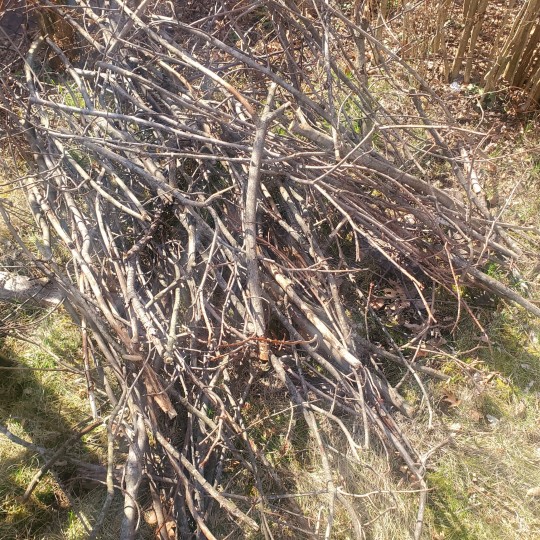

I'm going to convert my current vegetable garden to a native pollinator garden and use some of these logs and branches to start a hugelkultur raised bed. There's a huge area of bare soil in the yard where we had one of those tiny Intex pools, which I'm rehoming. I just don't have enough space or privacy for a pool and last year one of our cardinal fledglings fell into it (and quickly escaped thanks to critter pool ramps), so it's a safety concern for the wildlife.
The bare patch of soil is going to be a big vegetable, flower, and herb garden, with the hugelkultur positioned in the center. I'm hoping all the decaying wood, leaf litter, compost, and grass clippings from the hugel will yeild a nice healthy layer of soil. Leftover logs will be used to grow mushrooms and some of the smaller branches will be piled in a corner for fireflies and overwintering insects.
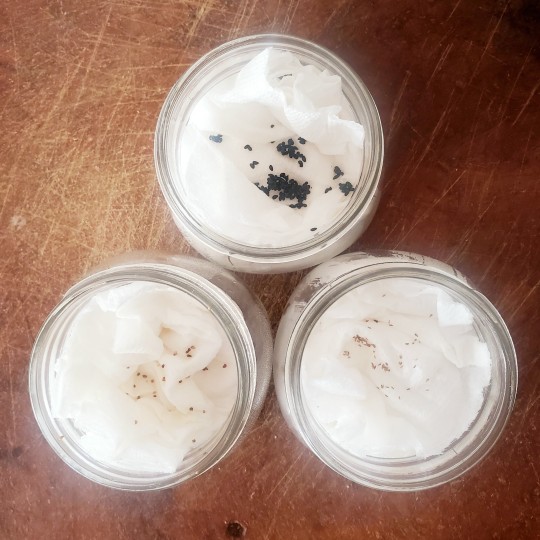
I also bought some native seeds for the pollinator garden. Right now I've got Wild Strawberry, Early Goldenrod, Red Columbine, and Spotted Touch-Me-Not in the fridge for stratification.
I've got Purple Coneflower started in pots and a packet of Blue Flag Iris seeds, which I'll be planting this autumn. We also have some American Cranberrybush and Bloodroot seeds, but I won't be starting those yet since they have double dormancy requirements. We already have Bloodroot in the garden but I want to plant even more.
At some point I want to try my hand at building a tiny pond for vernal pools. We have a slug problem so I really want to encourage toads and salamanders. I'm not sure if I want to do something above ground with lots or ramps and hiding spots or something in-ground but very shallow, like 6"-8" maximum depth.
It's going to be a busy spring!
7 notes
·
View notes
Text
As the leaves begin to fall in the temperate regions, decomposers become more commonly seen. Fallen leaves become leaf litter, which is the primary food source for many species of Pokémon. Leaf litter, if not eaten, can even become nutrient rich soil that Grass Types enjoy eating.
Seedot, Pineco and Sewaddle use leaf litter as natural camouflage. Because they blend in easily, early autumn is the best time for them to grow and mature. In turn, weaker predators like Spinarak and Bellsprout will grow in numbers as well.
With the changing of the seasons, many Pokémon will enter their pupal stage at the end of the autumnal season. As their preferred foods stop growing, Kakuna and Metapod will overwinter in a vegetative state not unlike hibernation.
3 notes
·
View notes
Text
i had been growing tomatoes because i like tomatoes and a neighbor had given away a start around the time i first tried to get into gardening so i had just stuck with that but i do wonder what vegetables are native to where i live it i grow in a raised bed with storebought soil because i can't bend down/over very well so it's not the plants would match the soil to begin with but still the climate and pollinators could have an effect and it would just be interesting to eat food from here i think. after all the tomato plants freeze and die every year and we have to restart (i tried overwintering but accidentally shocked the plant by bringing it out all at once) and i haven't successfully saved seeds yet so that means rebuying :( which is definitely something that feeds into the whole... yknow. so plants that can handle the climate better would live longer. and maybe some wildlife would eat it too nothing really liked my tomatoes lol just the plant itself which would kill it so i had to fight them.... idk i don't get to do very many activities outside/in nature anymore it's harder for me to get around so im pretty stuck to sidewalks but this is something i can do in my backyard once it's spring again and if im not like. tomatoes were nice because i like to eat tomatoes and i'm still not totally opposed to growing them but i am realizing how much gardening as it was taught to me is about essentially removing the plant from as much nature as possible and that it would probably be a lot more efficient rewarding smarter and just better to work with nature instead of against because like? i mean that's just stupid it's so weird what we don't question SORRYYY THIS POST IS SO LONG i'm just typing as i think this through because it's interesting to me at least
#i get mad about people removing trees and leaves and not letting them rot a lot but then there's plenty of stuff that's been taught to me#that's like equally self destructive that i want to keep examining and sorting through
8 notes
·
View notes
Text
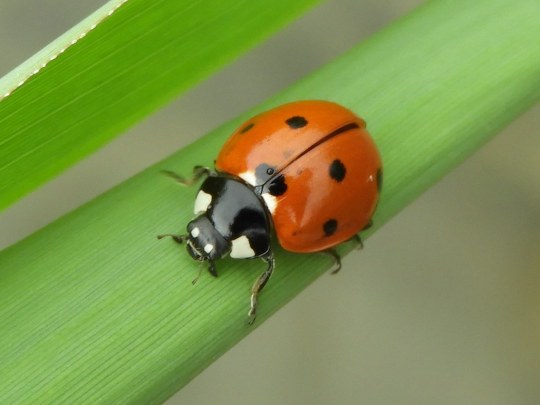
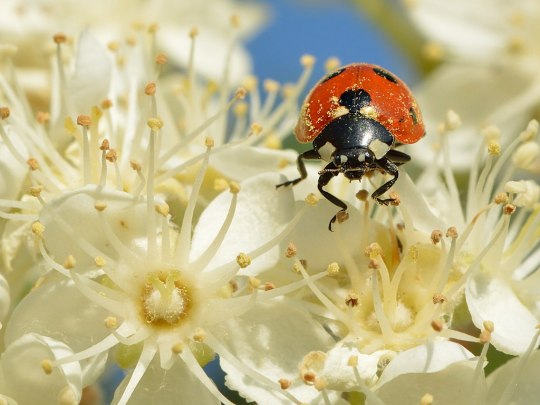
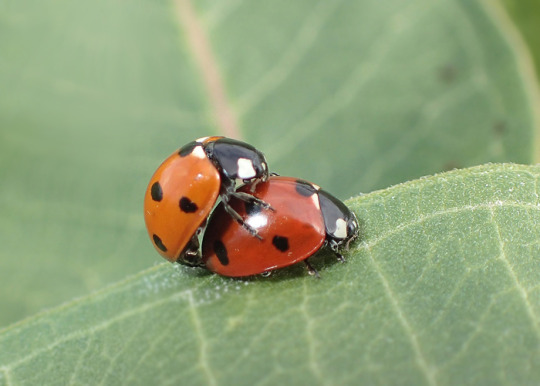


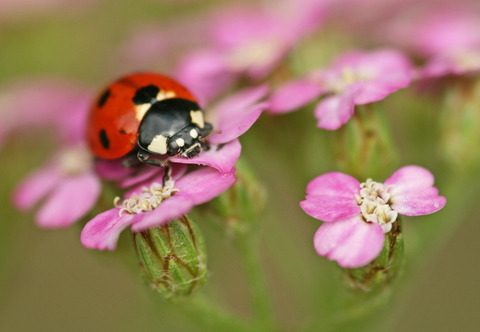

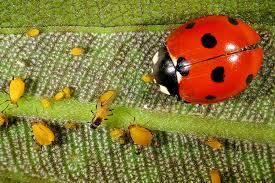

Coccinella septempunctata more commonly known as the seven-spot ladybird, seven-spotted ladybug, or C-7 beetle, is a species of ladybug which was originally endemic to mainland Europe and the middle east but thanks to humans and the spread of agriculture it can now be found all throughout North America, mainland Africa, mainland Asia, Australia, Japan, Indonesia, Madagascar, Cypress, Malta, Sri Lanka, and New Zealand. Here they dwell in a range of habitats including grasslands, meadows, steppe, gardens, forests, parks, marshes, and agricultural fields. Although both seven spot ladybug larvae and adults mainly eat aphids, pollen, and nectar, when aphids are not available these ladybugs are known feed upon other insects such as thrips, white flies, jumping plant lice, leafhoppers, and on the eggs of some beetles and butterflies. Reaching around .3 -.5 inches (7.6- 12.7mm) in length, adult seven-spot ladybirds have round bodies with black heads and abdomens and red thoraxs while the larvae are brownish-grey in colour, with four pairs of bright orange splotches across their bodies. Their distinctive spots and conspicuous colours warn of their toxicity, making them unappealing to predators. The species can secrete a fluid from joints in their legs which gives them a foul taste. A threatened ladybird may both play dead and secrete the unappetizing substance to protect itself. The seven-spot ladybird synthesizes the toxic alkaloids, N-oxide coccinelline and its free base precoccinelline; depending on sex and diet, the spot size and coloration can provide some indication of how toxic the individual insect is to potential predators. Breeding occurs from spring to fall, with seven spots often mating with several partners per day. Females may lay a cluster of 10-30 eggs on aphid-rich vegetation immediately, or, in fall, may store sperm and lay eggs in spring so their larvae have a more robust food supply. Eggs hatch after around 10 days as larvae eat and grow for another 21-30 days before entering the pupal stage, which lasts seven to 15 days. Adults overwinter in a state of diapause (dormancy) in leaf litter, dense vegetation, under tree bark, and in other sheltered spots. Ladybugs are unusual among insects with complete metamorphosis (egg-larva-pupa-adult) because both the larvae and the adults occupy the same spaces and eat the same thing. Under ideal conditions a seven spot ladybug may live upwards of a year.
#pleistocene#pleistocene pride#pliestocene pride#pliestocene#ice age#cenozoic#bug#bugs#ladybug#lady#ladybird#seven spotted ladybug#seven spotted lady beetle#beetle
9 notes
·
View notes
Text
Round 2 match 8A


The Fulvous Whistling Duck is not sexually dimorphic, which means females and males look the same. This duck, named for its tawny or “fulvous” colouration and whistling call, is one of two North American whistling duck species. They are commonly found in rice fields and marshes, where they spend their time foraging on vegetation.
The Long-tailed Duck is sexually dimorphic, meaning the females look different from the males. Female Long-Tailed Ducks are white and brown with grey bills. They have different winter and summer plumage, and are lighter in the winter and darker during the summer. They are a sea duck, and typically spend their winters in saltwater. Notably, quite a few of these birds also overwinter in Toronto, which is the largest urban centre in Canada.
#fulvous whistling duck#long-tailed duck#ducks#female duck poll#hens pens and geese#tumblr polls#round 2#tournament poll
4 notes
·
View notes
Text
Warbler Showdown pt 2; Bracket 1, Poll 4


Elfin-woods Warbler (Setophaga angelae)
IUCN Rating: Endangered
Range: Puerto Rico, possibly just El Yunque Forest in the east and Maricao Forest in the west.
Habitat: In El Yunque, they prefer the elfin cloud forest, where vegetation growth is stunted; they have also been found in the Palo Colorado forest at lower elevations. In Maricao, they prefer Podocarpus, a type of evergreen.
Subspecies: none
Cerulean Warbler (Setophaga cerulea)
IUCN Rating: Near Threatened
Range: breeds from the Midwest to New Jersey, mostly concentrated within West Virginia and the other Appalachan states around it. Overwinters in the northern Andes, from Venezuela to Peru.
Habitat: mature forests and large, tall broad-leaf trees, with a seeming preference for areas with canopy gaps, both in the breeding and overwintering range.
Subspecies: none
Image Sources: EWWA (Gloria Archilla) CERW (Joley Sullivan)
32 notes
·
View notes
Text
12 January Tips To Improve Your Dallas, GA Landscape

Preparing Your Georgia Landscape for Spring: Essential January Tasks
As the new year begins and the chill of winter lingers in Dallas, Georgia, it’s the perfect time to start preparing your landscape for the vibrant spring months ahead. January is a crucial period for garden maintenance, soil care, and strategic planning. By taking the right steps now, you can ensure a flourishing and healthy landscape when warmer weather arrives. Here’s a detailed guide to help you tackle essential January tasks and set the stage for a stunning spring garden.
1. Assess Your Landscape Before Spring
Before diving into tasks, take a comprehensive look at your landscape. Walk around your property with a notepad, evaluating:
Tree and Shrub Health: Look for broken branches, signs of disease, or pest infestations.
Lawn Condition: Identify bare spots, moss growth, or drainage issues.
Garden Beds: Check for weed growth, soil compaction, and leftover plant debris from fall.
Irrigation Systems: Inspect for damage caused by freezing temperatures.
Documenting these observations will help you prioritize your tasks and ensure nothing is overlooked. If you have questions, one of Lawn Frogs Landscape’s trained landscape technicians can help.
2. Prune Trees and Shrubs In January

Key Pruning Tips:
Remove dead, damaged, or diseased branches.
Thin out overcrowded areas to allow light and air to reach the inner branches.
Avoid pruning spring-blooming plants like azaleas and dogwoods, as this can remove flower buds.
Use clean, sharp tools to prevent the spread of disease.
3. Clean Up Landscape & Garden Beds In Dallas, GA
Clearing out garden beds in January sets the stage for a productive growing season. Remove any lingering debris, such as fallen leaves, spent annuals, and weeds. This reduces the risk of pests and diseases overwintering in your garden.
Mulch Maintenance:
If you mulched your garden in the fall, check its condition. Replace or replenish mulch to maintain a 2-3 inch layer, which helps regulate soil temperature, retain moisture, and suppress weeds. Mulch installation is a vital component of curb appeal and healthy plants.
4. Test and Amend Your Soil
Healthy soil is the foundation of a thriving landscape. Conducting a soil test in January gives you insights into your soil’s pH, nutrient levels, and overall health.
Steps to Test Your Soil:
Collect samples from different areas of your garden.
Use a soil test kit or send samples to your local Cooperative Extension office.
Review the results and make necessary amendments, such as adding lime to raise pH or sulfur to lower it.
Organic Matter:
Incorporate organic matter, such as compost or well-rotted manure, to improve soil structure, fertility, and drainage.
5. Plan Your Spring Planting
January is an excellent time to plan your spring garden. Research plants that thrive in Georgia’s climate and consider:
Native Plants: These are well-adapted to local conditions and require less maintenance.
Seasonal Flowers: Add color with pansies, snapdragons, and petunias.
Vegetable Garden: Map out space for cool-season crops like lettuce, spinach, and carrots, which can be planted in late winter.
Create a planting calendar to organize your tasks and ensure timely planting.
6. Start Seeds Indoors
For gardeners eager to get a head start, January is perfect for starting seeds indoors. This gives your plants a head start and ensures they’re ready for transplanting when spring arrives.
Tips for Successful Seed Starting:
Use clean containers and high-quality seed-starting mix.
Provide adequate light with a sunny windowsill or grow lights.
Keep the soil consistently moist but not waterlogged.
Label each container to keep track of plant varieties.
7. Care for Your Lawn
While your lawn may be dormant in January, there are still steps you can take to prepare it for spring:
Aerate: If the soil is compacted, aerate the lawn to improve root access to air and nutrients.
Overseed: Address bare spots by overseeding with cool-season grass.
Fertilize: Apply a winter fertilizer to strengthen the roots.
Debris Removal: Clear leaves and debris to prevent fungal diseases.
8. Inspect and Maintain Tools
January is a quieter time in the garden, making it ideal for tool maintenance. Clean, sharpen, and oil your tools to ensure they’re ready for the busy spring season. Check equipment like lawnmowers and trimmers for necessary repairs or replacements.
9. Protect Plants from Frost

Covering them with frost blankets or burlap.
Mulching around the base to insulate roots.
Moving potted plants to sheltered areas.
10. Attract Beneficial Wildlife
Encourage pollinators and beneficial wildlife to your garden by:
Setting up bird feeders and baths.
Planting native shrubs that provide food and shelter.
Avoiding chemical pesticides that harm beneficial insects.
11. Evaluate Hardscapes
Winter is a great time to assess and maintain your hardscapes, such as:
Patios and Walkways: Repair cracks and clean surfaces.
Fences and Trellises: Check for damage and repaint or repair as needed.
Outdoor Lighting: Ensure all fixtures are working properly.
12. Educate Yourself On Georgia Landscaping
Use January’s slower pace to expand your gardening knowledge. Attend local gardening workshops, read books, or join online forums to learn new techniques and tips tailored to Georgia’s unique climate.
Conclusion
Preparing your Dallas, Georgia landscape in January is the key to a vibrant and thriving spring garden. By assessing your landscape, pruning, cleaning, planning, and taking proactive steps, you’ll set the stage for success. Start now, and you’ll enjoy the rewards of a healthy, beautiful outdoor space all season long. Happy gardening! Contact us today for any of your gardening projects.
CALL US NOW
0 notes